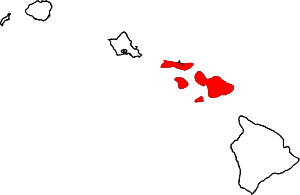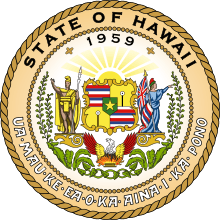Hana, Hawaii
Hana (Hawaiian: Hāna) is a census-designated place (CDP) in Maui County, Hawaii, United States. The population was 1,235 at the 2010 census.[1] Hana is located at the eastern end of the island of Maui and is one of the most isolated communities in the state. It is reached mainly via the Hana Highway, a long, winding, 52-mile-long (84 km) highway along Maui's northern shore and also using boats.
Hana, Hawaii Hāna | |
|---|---|
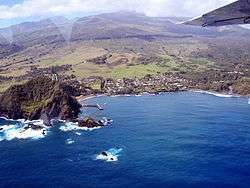 Aerial view of Hana, Maui | |
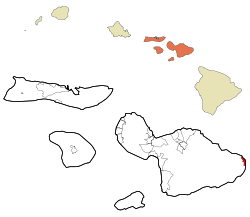 Location in Maui County and the state of Hawaii | |
| Coordinates: 20°46′12″N 155°59′39″W | |
| Country | United States |
| State | Hawaii |
| County | Maui |
| Area | |
| • Total | 11.7 sq mi (30.3 km2) |
| • Land | 10.5 sq mi (27.3 km2) |
| • Water | 1.2 sq mi (3.0 km2) |
| Elevation | 128 ft (39 m) |
| Population (2010) | |
| • Total | 1,235 |
| • Density | 110/sq mi (41/km2) |
| Time zone | UTC-10 (Hawaii-Aleutian) |
| ZIP code | 96713 |
| Area code(s) | 808 |
| FIPS code | 15-11350 |
| GNIS feature ID | 0359013 |
History
.svg.png)
.svg.png)
Like most of Hawaii, Hana was probably first settled between 500 and 800 AD by Polynesian peoples.[2]
The first sugarcane plantation in the area was established by George Wilfong in 1849, and by 1883 there were six plantations operating in the area. By 1946, however, the last sugarcane plantation had closed, leading plantation workers to move mostly to the west side of Maui. That same year saw the opening of the Ka-'uiki Inn, today known as the Hotel Travaasa - Hana, which helped transition the economy towards tourism.[2]
The winding, famously scenic Hana Highway was completed in 1926. Originally paved with gravel, it provided the first land vehicle access to the town. Hana's population peaked in the first half of the twentieth century, with a population of about 3,500.[2]
Geography and climate
Hana is located at 20°46′12″N 155°59′39″W (20.770017, −155.994179),[3] directly on the East Rift Zone of East Maui Volcano (Haleakalā). The Hana Airport offers flights with regular service to the Big Island, Kahului, and Oahu.
According to the United States Census Bureau, this CDP has a total area of 11.7 square miles (30.3 km2), of which 10.5 square miles (27.3 km2) is land and 1.2 square miles (3.0 km2), 9.77%, is water.[4]
Near Hana are natural areas and several swimming holes in the Haleakala National Park.
Hana's climate is hot and wet year round, typical of a tropical rainforest.
| Climate data for Hana Airport 355, HI US (1981-2010) | |||||||||||||
|---|---|---|---|---|---|---|---|---|---|---|---|---|---|
| Month | Jan | Feb | Mar | Apr | May | Jun | Jul | Aug | Sep | Oct | Nov | Dec | Year |
| Average high °F (°C) | 78.0 (25.6) |
77.7 (25.4) |
77.9 (25.5) |
78.5 (25.8) |
79.7 (26.5) |
81.7 (27.6) |
82.1 (27.8) |
82.9 (28.3) |
82.9 (28.3) |
82.2 (27.9) |
80.3 (26.8) |
78.6 (25.9) |
80.2 (26.8) |
| Average low °F (°C) | 64.9 (18.3) |
64.4 (18.0) |
65.4 (18.6) |
66.9 (19.4) |
68.2 (20.1) |
69.7 (20.9) |
70.8 (21.6) |
71.6 (22.0) |
70.4 (21.3) |
70.2 (21.2) |
69.5 (20.8) |
66.8 (19.3) |
68.2 (20.1) |
| Average precipitation inches (mm) | 7.77 (197) |
4.91 (125) |
8.99 (228) |
7.11 (181) |
5.58 (142) |
4.31 (109) |
5.94 (151) |
5.77 (147) |
6.82 (173) |
7.28 (185) |
7.77 (197) |
6.98 (177) |
79.23 (2,012) |
| Source: NOAA [5] | |||||||||||||
Demographics
As of the census[6] of 2010,[1] Hana had 1,235 residents, 390 households, and 252 families residing in the CDP. The 2010 population density was 105.6 people per square mile (40.8 people per square kilometer). There were 506 housing units at an average density of 48.2/sq mi. The racial makeup of the CDP was 22.2% White, 0.1% African American, 0.1% American Indian and Alaska Native, 5.0% Asian, 29.1% Pacific Islander, 0.8% from some other race, and 42.8% from two or more races. Hispanic or Latino of any race were 9.8% of the population.
As of 2010, there were 390 households, out of which 23.8% had children under the age of 18 living with them, 45.6% were headed by married couples living together, 9.7% had a female householder with no husband present, and 35.4% were non-families. 29.5% of all households were made up of individuals, and 9.7% were someone living alone who was 65 years of age or older. The average household size was 3.17, and the average family size was 3.99.
As of 2010, in the CDP the population was spread out, with 27.8% under the age of 18, 8.5% from 18 to 24, 24.3% from 25 to 44, 25.7% from 45 to 64, and 13.5% who were 65 years of age or older. The median age was 35.2 years. For every 100 females, there were 105.5 males. For every 100 females age 18 and over, there were 111.9 males.
As of 2000, the median income for a household in the CDP was $50,833, and the median income for a family was $54,167. Males had a median income of $26,146 versus $22,969 for females. The per capita income for the CDP was $14,672. About 5.6% of families and 8.6% of the population were below the poverty line, including 10.4% of those under age 18 and 3.8% of those age 65 or over.
Points of interest
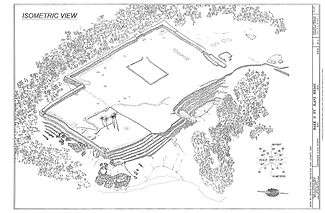
- Pi'i-lani Temple - constructed in the 15th century, this is the largest temple in Hawaii[7]
- Kahanu Garden
- Kaia Ranch Tropical Botanical Gardens
- Hana Beach Park
- Hana Ball Park
- Pailoa Bay
- Hamoa Beach
- Wai'anapanapa State Park
- Hasegawa General Store[8]
Popular culture
Hana's surfing culture was profiled by writer Susan Orlean in Outside magazine in 1998, inspiring the 2002 film Blue Crush.[9]
Health care
Although not technically a hospital or emergency room, Hana Health Clinic (or Hana Medical Center), works in cooperation with American Medical Response and Maui Memorial Medical Center to stabilize and transport patients with emergent medical conditions. It is open 24/7 for urgent care and emergency access. The facility also offers routine physical exams, acute care, chronic disease management (heart disease, diabetes, asthma), cancer screening (Pap smears, mammograms, prostate and colon), routine gynecology, family planning services, basic laboratory and x-ray, on-site medication dispensary, and referrals for specialty care.[10]
Economy
Major employers in Hana include the Travaasa Hana hotel, Hana High and Elementary School, and Waiʻanapanapa State Park.[11]
Notable residents
- Queen Kaʻahumanu, born in Hana in 1768[2]
- Charles Lindbergh, retired there in the 1970s and was buried near Hana in 1974[2]
- Pat Benatar, married to Neil Giraldo in Hana in 1982, has houses in Hana and in California.
- George Harrison and his wife Olivia Harrison had a property in Hana. Harrison wrote the song Soft-Hearted Hana about time spent in Hawaii.
- Frank Herbert, the science fiction author, moved to Hana in 1980, toward the end of his life.
Gallery
 Hana Beach Park
Hana Beach Park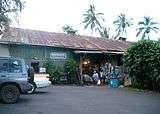 Hasegawa General Store
Hasegawa General Store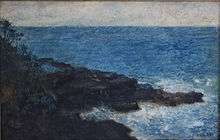 'Hana Maui Coast',
'Hana Maui Coast',
by Charles W. Bartlett (1920)
References
- "Profile of General Population and Housing Characteristics: 2010 Demographic Profile Data (DP-1): Hana CDP, Hawaii". United States Census Bureau. Retrieved December 28, 2011.
- "Hana Chronology". Archived from the original on November 17, 2018. Retrieved November 24, 2012.
- "US Gazetteer files: 2010, 2000, and 1990". United States Census Bureau. 2011-02-12. Retrieved 2011-04-23.
- "Geographic Identifiers: 2010 Demographic Profile Data (G001): Hana CDP, Hawaii". United States Census Bureau. Retrieved December 28, 2011.
- "Data Tools: 1981-2010 Normals". NOAA. 2016. Retrieved on March 16, 2016.
- "U.S. Census website". United States Census Bureau. Retrieved 2008-01-31.
- Hanamaui.com
- Hasegawa General Store
- Orlean, Susan. "Life's Swell". Outside. Retrieved September 12, 2002.
- "Hana Health Clinic". Retrieved 10 October 2014.
- Search Results - Hana, Hawaii - ReferenceUSA Current Businesses
| Wikimedia Commons has media related to Hana, Hawaii. |
